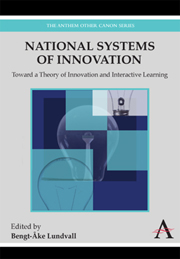Book contents
- Frontmatter
- Contents
- List of Tables
- List of Figures
- Preface
- 1 Introduction
- Part I Toward a New Approach to National Systems of Innovation
- Part II A Closer Look at National Systems of Innovation
- Part III Opening National Systems of Innovation: Specialisation, Multinational Corporations and Integration
- 10 Export Specialisation, Structural Competitiveness and National Systems of Innovation
- 11 The Home Market Hypothesis Re-examined: The Impact of Domestic User-Producer Interaction on Export Specialisation
- 12 Integration, Innovation and Evolution
- 13 National Systems of Innovation, Foreign Direct Investment and the Operations of Multinational Enterprises
- 14 Public Policy in the Learning Society
- 15 Post Script: Innovation System Research – Where It Came From and Where It Might Go
- Notes
- References
14 - Public Policy in the Learning Society
from Part III - Opening National Systems of Innovation: Specialisation, Multinational Corporations and Integration
Published online by Cambridge University Press: 05 March 2012
- Frontmatter
- Contents
- List of Tables
- List of Figures
- Preface
- 1 Introduction
- Part I Toward a New Approach to National Systems of Innovation
- Part II A Closer Look at National Systems of Innovation
- Part III Opening National Systems of Innovation: Specialisation, Multinational Corporations and Integration
- 10 Export Specialisation, Structural Competitiveness and National Systems of Innovation
- 11 The Home Market Hypothesis Re-examined: The Impact of Domestic User-Producer Interaction on Export Specialisation
- 12 Integration, Innovation and Evolution
- 13 National Systems of Innovation, Foreign Direct Investment and the Operations of Multinational Enterprises
- 14 Public Policy in the Learning Society
- 15 Post Script: Innovation System Research – Where It Came From and Where It Might Go
- Notes
- References
Summary
Introduction
Recently, several writers have argued that globalisation erodes national specificity and leads to long term convergence of structure, institutional set up, culture and, as a consequence, economic performance of countries. This does not correspond to observable facts nor has it been the message of this book. One of the most interesting developments of the 1980's is that despite globalisation, the distinctive features of national environments, have attracted much greater analytical attention than previously (Porter, 1990, Butry, 1991) and are seen by many authors as explaining differences among countries in competitiveness, growth and income.
While the post war, ‘golden age’ growth period from the early 1950's to the early 1970's was characterised by convergence between the OECD countries (Gomulka, 1971, Cornwall, 1977, Maddison, 1982 and Abramovitz, 1989), as well as by a trend towards an increase in economic and social integration and reduction in inequalities inside nations (cf. the small but real closing of the gab between the Mezzogiornio and Northern Italy and a lowering of income distribution inequality in many OECD countries), the diverging features have been significantly more important in the two following decades.
National specificity remains important and appears quite definitely to bear a relation to the capacity to produce, acquire, adopt and use technology. The erosion of the autonomy of national systems through globalisation is not synonymous with convergence and improved integration.
- Type
- Chapter
- Information
- National Systems of InnovationToward a Theory of Innovation and Interactive Learning, pp. 293 - 316Publisher: Anthem PressPrint publication year: 2010
- 4
- Cited by



